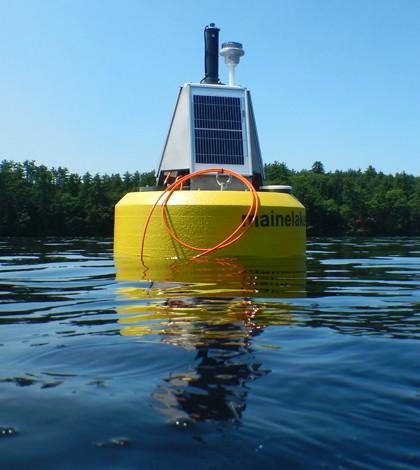GLEON 10th anniversary marks a decade of collaborative lake research

The water quality data buoy floating on Highland Lake (Credit: Lakes Environmental Association)
The Global Lake Ecological Observatory Network turned 10 this month. According to the GLEON Facebook page, the group held their first meeting on the University of California San Diego Campus in March 2005. They’ve since led the lake science community in coordinating high-frequency sensor data from lakes across the planet.
They didn’t have their namesake acronym ready by the time many GLEON founders published this article in the journal BioScience, but the article lays the groundwork for the group’s focus on wireless sensor networks “allowing ecologists and field biologists to engage in intensive and expansive sampling and to unobtrusively collect new types of data.”
We’ve covered quite a few GLEON buoy sites projects in the past few years, and the 10th anniversary seemed to be a fine occasion to gather up all those stories (or at least all those I could track down) in one place.
Frequent mixing on Lake Rerewhakaaitu, New Zealand
This lake on New Zealand’s North Island mixes several times a year, making traditional water quality sampling methods inadequate for capturing important lake processes. A new data buoy there will help scientists learn more about the polymictic lake’s oxygen dynamics and water column production. They’re planning to share data through GLEON, and hoping to learn whether the lake’s iron-rich sediments make it more vulnerable to anoxic events.
Aftermath of Hurricane Irene on Lake Lacawac, Pennsylvania
Lake Lacawac is a GLEON site, but this story covers a little bit more about the kind of collaborative research the network can facilitate. After the remnants of Hurricane Irene swept across the U.S. Northeast, researchers gathered data from a buoys on Lake Lacawac and eight other lakes in a sweeping study of the storm’s effects on the region’s lakes. The regional look produced insights that no single site could have provided.
Keeping on eye on clarity on Highland Lake, Maine
The Lakes Environment Association operates a data buoy on Highland Lake as part of its water quality monitoring program that covers 40 lakes across western Maine. Highland Lake was of particular interest because an out-of-character algal bloom clouded the lake’s clear water in 2002. The community was also interested enough to cover the costs of six oxygen sensors to track hypoxia throughout the water column.
“Goldie” floating on Great Pond, Maine
The inspiration for the play and movie “On Golden Pond,” Great Pond is in the midst of a slow decline in water quality that scientists fear could signal an approaching ecological tipping point. “Goldie” the data buoy has watched water quality there for the past two years, and its operators are pioneering graphical interface and other tools to help communicate the data to lake residents.

Trends in oxygen concentrations (in red) on Great Pond for 2013 and 2014 (Credit: Whitney King/Colby College)
Protecting drinking water on Lake Auburn, Maine
This Maine lake (notice a trend? Mainers have some exceptional lakes and they’d like to keep them that way) is a drinking water source that’s so clean and clear that the local water district has a waiver exempting it from filtering requirements. But after 2012 bloom brought on anoxia and a fish kill, the Auburn Water District and Bates College partnered to bring a data buoy to the lake to get a better idea of what’s going on.
Uncovering the cause of blooms on Lake Lillinonah, Connecticut
Lake Lillinonah is a eutrophic reservoir where the nutrient levels are almost always high enough to trigger an algal bloom, but the algae aren’t always blooming. A water quality data buoy is helping scientists learn more about the role that lake’s highly dynamic mixing patterns might play in blooms. The buoy has also given a sense of credibility to Friends of the Lake, a Lillinonah advocacy group.
Top image: The water quality data buoy floating on Highland Lake (Credit: Lakes Environmental Association)




0 comments